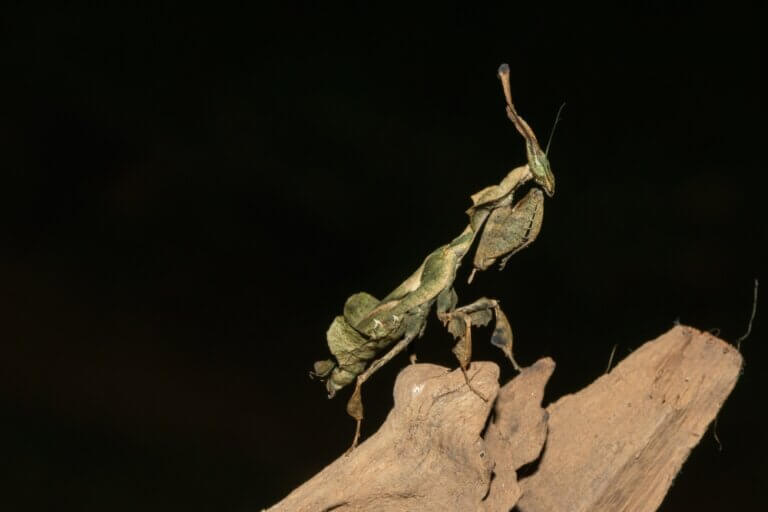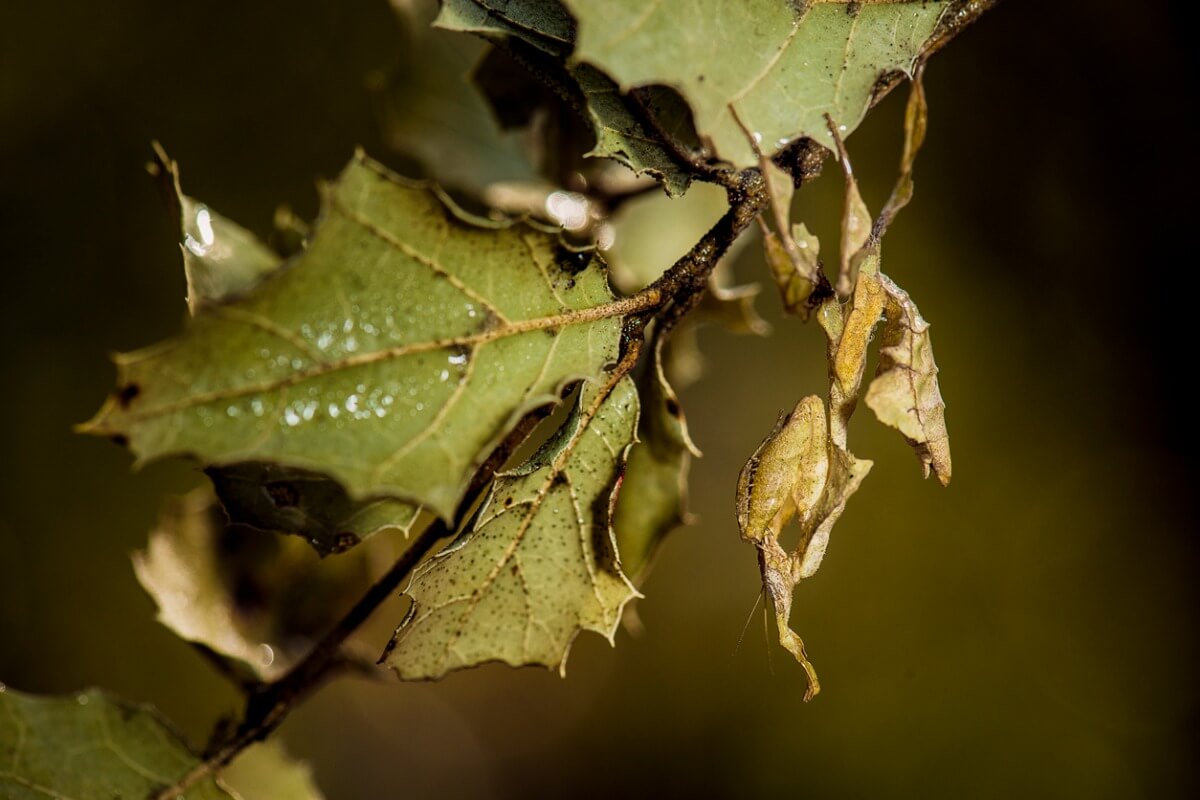Ghost Mantis: Habitat and Characteristics


Reviewed and approved by the biologist Samuel Sanchez
The ghost mantis (Phyllocrania paradoxa) is a species of insect that belongs to the family Hymenopodidae (order Mantodea) and is native to southern Africa. It’s often called the dead leaf mantis, due to its extraordinary camouflaging ability with which it simulates a dead or withered leaf.
This biological adaptation allows the phantom mantis to go unnoticed by potential predators and, at the same time, helps it to evade being detected by its prey during hunts. In addition, it’s an easy insect to look after and has become a popular pet in the terrarium world. Below, you’ll learn about its main attributes and care.
Ghost mantis habitat
The ghost mantis is a unique species in the world that’s found naturally in Africa, specifically in the territory from Senegal to Somalia, as well as on the island of Madagascar. Its preferred habitat is the scrub and semi-arid forest biome, where it mimics the leaves and dry branches.

Physical characteristics
The ghost mantis is one of the smallest mantis species, measuring only 45 to 50 millimeters long (around 2 inches). Its colors are those that allow it to mimic the environment and look like a dead or decaying leaf: the brown, greenish-gray, or black that its body exhibits are also typical tones of the soil.
This insect carries out different exoskeleton molts to grow during its short life expectancy (which is no more than a year) and its development rate depends on the amount of food it consumes and its metabolism. Interestingly, it has been observed that the colors of the mantis vary according to the level of humidity that it’s exposed to, and can be classified as follows:
- Green: Humidity above 80%.
- Light brown: Humidity around 70%.
- Dark brown: Humidity between 40 and 50%.
- Black: Humidity less than 30%.
It has an elongated head with an extended and flattened prothorax. It also has protuberances on its extremities that facilitate its camouflage. It also has a dorsal keel that resembles a desiccated leaf, and the folds of its wings are actually shadows of pigment.
Its great ability to blend in with the leaf litter and its temporary immobility help it go unnoticed by predators such as birds, which tend to ignore insects that resemble the environment. Interestingly, the ghost mantis also practices thanatosis (playing dead) when it feels threatened.
If none of this works, then the mantis can take flight thanks to its hind wings.
Ghost mantis nutrition
This insect is strictly carnivorous and has a clear preference for flying prey, such as flies or moths. However, in captivity, it can feed on small worms and crickets, although it also accepts cockroaches of a suitable size.
When ensured a varied diet, ghost mantis will be in better health. The young can feed on fruit flies, but the size of their prey should be increased as soon as they grow a little.
Reproduction of the ghost mantis
This insect’s reproduction takes place 2 to 4 weeks after the last molt. To copulate, the male mounts on top of the female and fertilizes her internally after several hours of mating. After 3 weeks, the female deposits 5 to 6 brown oothecae (foamy egg sacs) on branches or walls (of the terrarium or natural environment).
Ghost mantis nymphs hatch after 6 weeks of incubation and, usually, 10 to 30 nymphs emerge from each ootheca. At hatching, they may be dark in color, although after a few days or weeks they take on a glossy black hue that can vary over time depending on humidity (as explained above).
Captive care
Being an African species, the ghost mantis tolerates high temperatures well. However, it can also tolerate low temperatures, although the recommended standard for its terrarium should be no higher than 30 degrees Celsius and no lower than 18 degrees Celsius (86 and 64 degrees Fahrenheit respectively).
Terrarium humidity in captivity should be 60-70% for adults. However, the nymphs of this insect species require higher levels to help facilitate their molting, so a humidity between 70-80% is recommended in order to avoid possible deaths or deformations.
This aspect is essential for the animal’s molting, as low humidity means that the ghost mantis cannot detach from its old exoskeleton and it loses some of its limbs. On the contrary, too high a humidity (more than 90%) will make it unable to harden its new exoskeleton after shedding its skin and will cause health problems in the future.
It’s generally recommended to have one female and one male, each one housed in a terrarium of 35 centimeters high by 20 centimeters wide and 20 centimeters deep (16 x 8 x 8 inches). In the case of nymphs, they can be kept together in the same installation until they grow a little, as the level of cannibalism isn’t very high.
The decoration of the space requires elements such as branches, dry plants, or any object that simulates the semi-arid forest biome. As for lighting, this species has no great requirements and the light from a nearby window is more than enough.
Mantids need a lot of ventilation to thrive. Make sure that the terrarium lid has holes or a wire mesh.

As you can see, the ghost mantis is a curious insect that uses its camouflage well to survive. Temperature, humidity, and lighting are important aspects for their care in captivity as well as their diet, as they’ll determine their growth over time.
The ghost mantis (Phyllocrania paradoxa) is a species of insect that belongs to the family Hymenopodidae (order Mantodea) and is native to southern Africa. It’s often called the dead leaf mantis, due to its extraordinary camouflaging ability with which it simulates a dead or withered leaf.
This biological adaptation allows the phantom mantis to go unnoticed by potential predators and, at the same time, helps it to evade being detected by its prey during hunts. In addition, it’s an easy insect to look after and has become a popular pet in the terrarium world. Below, you’ll learn about its main attributes and care.
Ghost mantis habitat
The ghost mantis is a unique species in the world that’s found naturally in Africa, specifically in the territory from Senegal to Somalia, as well as on the island of Madagascar. Its preferred habitat is the scrub and semi-arid forest biome, where it mimics the leaves and dry branches.

Physical characteristics
The ghost mantis is one of the smallest mantis species, measuring only 45 to 50 millimeters long (around 2 inches). Its colors are those that allow it to mimic the environment and look like a dead or decaying leaf: the brown, greenish-gray, or black that its body exhibits are also typical tones of the soil.
This insect carries out different exoskeleton molts to grow during its short life expectancy (which is no more than a year) and its development rate depends on the amount of food it consumes and its metabolism. Interestingly, it has been observed that the colors of the mantis vary according to the level of humidity that it’s exposed to, and can be classified as follows:
- Green: Humidity above 80%.
- Light brown: Humidity around 70%.
- Dark brown: Humidity between 40 and 50%.
- Black: Humidity less than 30%.
It has an elongated head with an extended and flattened prothorax. It also has protuberances on its extremities that facilitate its camouflage. It also has a dorsal keel that resembles a desiccated leaf, and the folds of its wings are actually shadows of pigment.
Its great ability to blend in with the leaf litter and its temporary immobility help it go unnoticed by predators such as birds, which tend to ignore insects that resemble the environment. Interestingly, the ghost mantis also practices thanatosis (playing dead) when it feels threatened.
If none of this works, then the mantis can take flight thanks to its hind wings.
Ghost mantis nutrition
This insect is strictly carnivorous and has a clear preference for flying prey, such as flies or moths. However, in captivity, it can feed on small worms and crickets, although it also accepts cockroaches of a suitable size.
When ensured a varied diet, ghost mantis will be in better health. The young can feed on fruit flies, but the size of their prey should be increased as soon as they grow a little.
Reproduction of the ghost mantis
This insect’s reproduction takes place 2 to 4 weeks after the last molt. To copulate, the male mounts on top of the female and fertilizes her internally after several hours of mating. After 3 weeks, the female deposits 5 to 6 brown oothecae (foamy egg sacs) on branches or walls (of the terrarium or natural environment).
Ghost mantis nymphs hatch after 6 weeks of incubation and, usually, 10 to 30 nymphs emerge from each ootheca. At hatching, they may be dark in color, although after a few days or weeks they take on a glossy black hue that can vary over time depending on humidity (as explained above).
Captive care
Being an African species, the ghost mantis tolerates high temperatures well. However, it can also tolerate low temperatures, although the recommended standard for its terrarium should be no higher than 30 degrees Celsius and no lower than 18 degrees Celsius (86 and 64 degrees Fahrenheit respectively).
Terrarium humidity in captivity should be 60-70% for adults. However, the nymphs of this insect species require higher levels to help facilitate their molting, so a humidity between 70-80% is recommended in order to avoid possible deaths or deformations.
This aspect is essential for the animal’s molting, as low humidity means that the ghost mantis cannot detach from its old exoskeleton and it loses some of its limbs. On the contrary, too high a humidity (more than 90%) will make it unable to harden its new exoskeleton after shedding its skin and will cause health problems in the future.
It’s generally recommended to have one female and one male, each one housed in a terrarium of 35 centimeters high by 20 centimeters wide and 20 centimeters deep (16 x 8 x 8 inches). In the case of nymphs, they can be kept together in the same installation until they grow a little, as the level of cannibalism isn’t very high.
The decoration of the space requires elements such as branches, dry plants, or any object that simulates the semi-arid forest biome. As for lighting, this species has no great requirements and the light from a nearby window is more than enough.
Mantids need a lot of ventilation to thrive. Make sure that the terrarium lid has holes or a wire mesh.

As you can see, the ghost mantis is a curious insect that uses its camouflage well to survive. Temperature, humidity, and lighting are important aspects for their care in captivity as well as their diet, as they’ll determine their growth over time.
All cited sources were thoroughly reviewed by our team to ensure their quality, reliability, currency, and validity. The bibliography of this article was considered reliable and of academic or scientific accuracy.
- Oufiero, C. E., Nguyen, T., Sragner, A., & Ellis, A. (2016). Patterns of variation in feeding strike kinematics of juvenile ghost praying mantis (Phyllocrania paradoxa): are components of the strike stereotypic?. Journal of Experimental Biology, 219(17), 2733-2742. Recogido el 9 de noviembre de 2021 de: https://journals.biologists.com/jeb/article/219/17/2733/15387/Patterns-of-variation-in-feeding-strike-kinematics
- Fernández, M. D. Sobre las ootecas de los mántidos (Insecta, Mantodea) de Castilla-La Mancha (España). Recogido el 11 de noviembre de 2021 de: https://www.researchgate.net/profile/Miguel-Domenech-Fernandez/publication/344072137_Sobre_las_ootecas_de_los_mantidos_Insecta_Mantodea_de_Castilla-La_Mancha_Espana_About_the_oothecae_of_the_mantids_Insecta_Mantodea_of_Castilla-La_Mancha_Spain/links/5f50dcb992851c250b8c7ccd/Sobre-las-ootecas-de-los-mantidos-Insecta-Mantodea-de-Castilla-La-Mancha-Espana-About-the-oothecae-of-the-mantids-Insecta-Mantodea-of-Castilla-La-Mancha-Spain.pdf
This text is provided for informational purposes only and does not replace consultation with a professional. If in doubt, consult your specialist.








